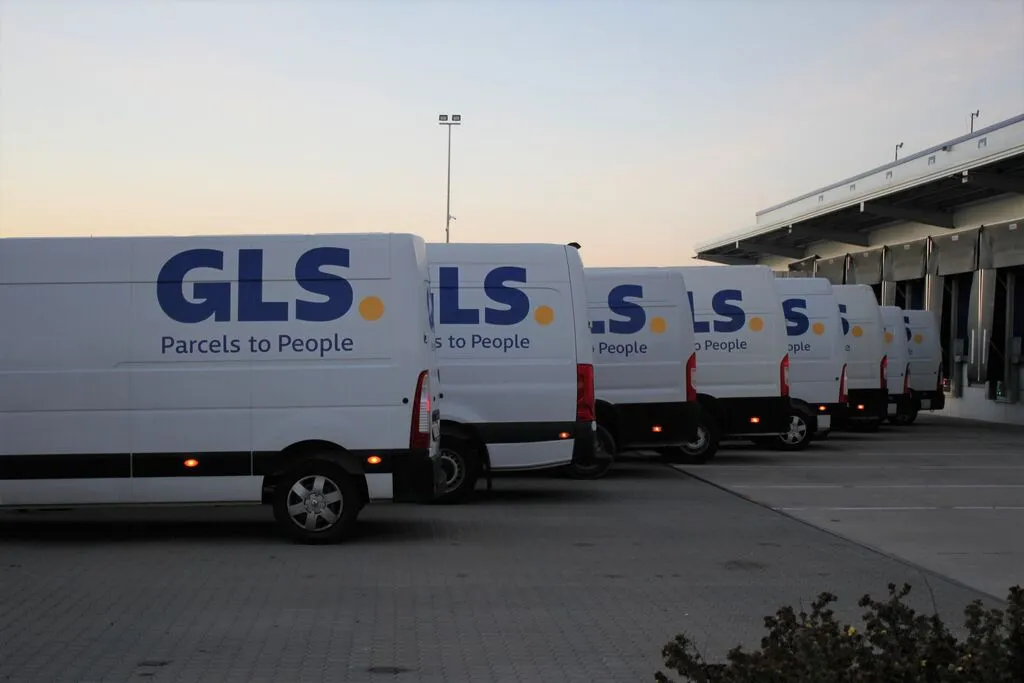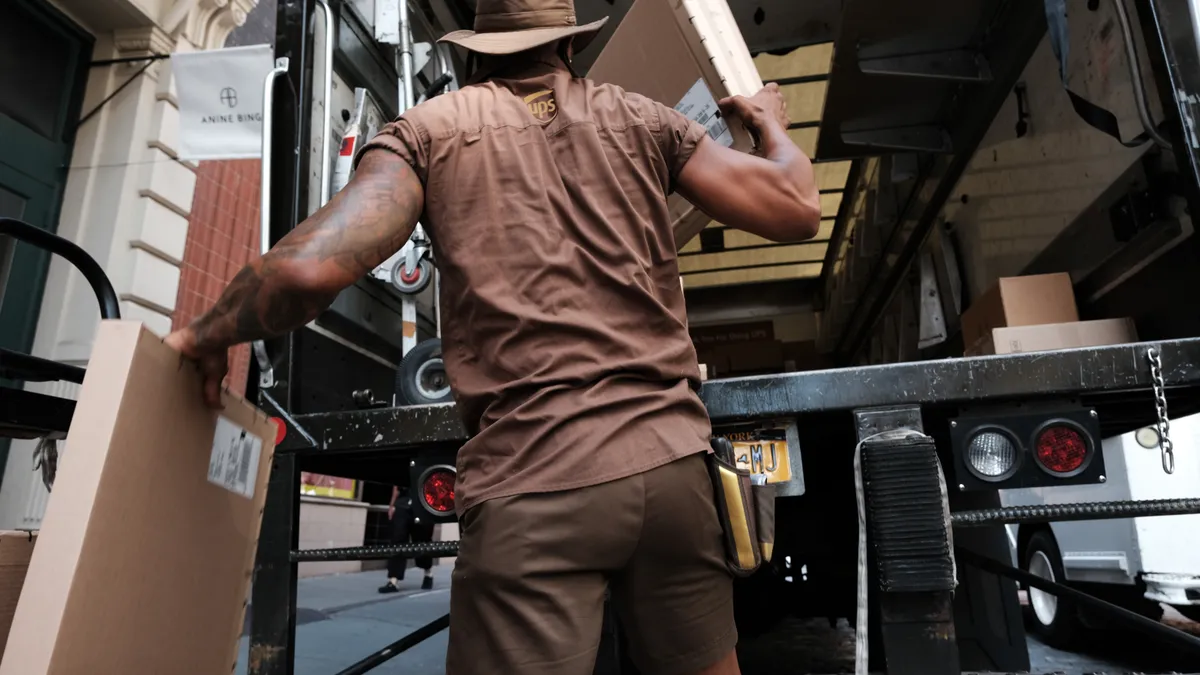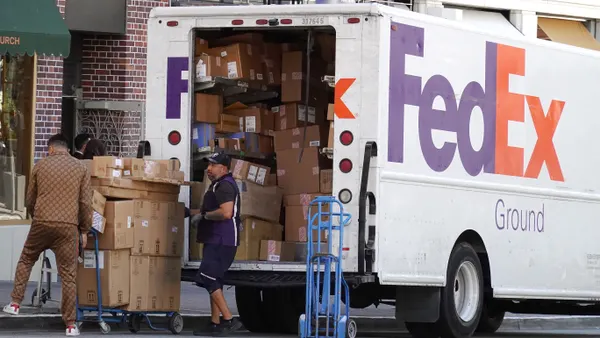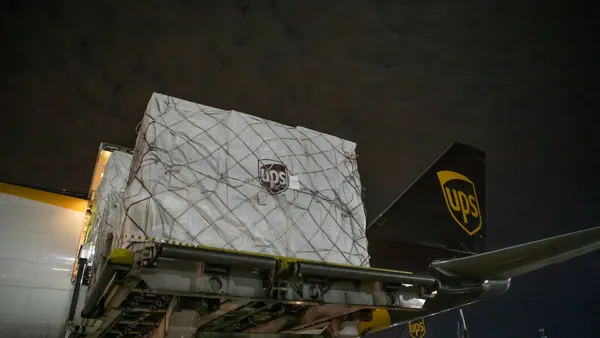Parcel shippers may opt to use fewer delivery providers in 2024, countering the push for carrier diversification that became prevalent amid pandemic-related challenges.
Smaller, regional delivery providers — those outside the FedEx, UPS and U.S. Postal Service realm — are particularly vulnerable to potential reductions, experts told Supply Chain Dive. Major carriers are offering shipping discounts to counteract volume declines, and customers may find it harder to justify splitting shipments among a wide array of carriers in an uncertain demand environment.
“There probably will be some consolidation this next year,” said Andy Whiting, co-founder and CEO of the parcel carrier Better Trucks. “For us, it just means we want to make sure that we have this really solid distribution-to-doorstep network that's very valuable for customers. They're evaluating us against FedEx and UPS.”
Carrier consolidation is already happening. The number of carriers shippers used jumped in the summer as companies made preparations to mitigate disruptions from a potential UPS strike. But with strike concerns alleviated, diversification is dipping like it did at the start of 2023.
The number of carriers per company account has declined for three consecutive months, dropping to 5.74 in December, according to data project44 shared with Supply Chain Dive.
Carrier diversification dwindles to end year
"At some point, there's not enough [volume] to go around for five carriers — there just isn't," said Josh Dinneen, chief commercial officer of the parcel carrier OnTrac, in an interview last year.
FedEx, UPS take share with discounts
Capacity is no longer a concern as delivery demand has softened, meaning carriers have to compete more aggressively to draw additional volume and revenue into their networks. Enter discounts from the likes of FedEx and UPS to grab more market share and attract cost-conscious customers.
In a LinkedIn post earlier this month, Dean Maciuba, managing partner, United States, for Crossroads Parcel Consulting, said FedEx offered discounts to businesses with little or no shipping revenue tied to their accounts. The offer claimed eligible shippers could tap into the savings via FedEx's small business discount program.
Meanwhile, UPS is fighting to regain volume that it lost during contentious contract negotiations with the International Brotherhood of Teamsters in the summer. Rent the Runway was among the customers that capitalized by locking in more favorable rates, in exchange for UPS handling most of the company’s shipping needs.
"We've had a couple of clients that were strong UPS clients that jumped ship and now UPS is eager to get that business back," said Stephanie Martin, CEO of Navigo Consulting Group, a transportation spend consultancy.
Of the 1.5 million packages per day that shippers diverted to FedEx, the U.S. Postal Service and other carriers due to the negotiations, UPS regained roughly 40% of that volume as of October. Half of that recapture came from FedEx, CEO Carol Tomé said in an earnings call.
However, FedEx Chief Customer Officer Brie Carere maintained in December that the company is still holding onto the 400,000 packages it gained from UPS during the uncertainty, meaning the volume UPS took back would have to come from the Postal Service or smaller providers.
Regardless, both delivery giants reaped the benefits of their efforts to grab more packages during the busy shipping week of Black Friday. Over that period, they took a larger share of volume from regional delivery providers than the year prior, according to Shipium data.
Alternative carriers still offer upside
While FedEx and UPS' discounting efforts pose a challenge for smaller delivery providers looking to gain share in the market, shippers wouldn't abandon alternative carriers entirely, experts said.
After all, it has become easier for shippers to diversify their carrier base thanks to the emergence of third-party tools in recent years. Additionally, regional carriers have expanded their own service offerings while adapting to UPS and FedEx's pricing strategies.
"We've seen very, very competitive rates from the regional carriers, and we see service improvements with the regional carriers as well," Martin said.
Delivery needs and carrier preferences vary on a client-by-client basis, meaning there is no magic number of carriers a company should have, Martin said. However, business-to-consumer retailers tend to embrace a multi-carrier model moreso than shippers in other industries, she added.
"They want the flexibility of being able to shift volume and use different carriers," Martin said.
For shippers looking to diversify, service reliability is a top concern, along with ease of use and implementation. They want a delivery service that looks and feels like what they expect from UPS and FedEx without the complexities that often come with adding more carriers, Better Trucks’ Whiting said.
"They don't want to have to have a huge logistics team internally to think about how we divvy up all this volume and how do we optimize our spend," he said. "They basically want to have the easy button."

How FedEx, UPS competitors are adjusting
Executives at smaller parcel carriers told Supply Chain Dive they're focused on maintaining high service levels in existing markets to keep current customers happy. Expansion in 2024 will happen in a more careful manner compared to years' past.
If shippers end up reducing their carrier mix this year, smaller delivery providers may pivot into specialty shipping services and expand their offerings when the demand environment improves, GLS US President Steven Bergan said.
One tactic to fuel growth has been to collaborate with other regional carriers. GLS and Better Trucks launched a partnership last year allowing customers of each company to access the coverage area of the other carrier for deliveries. GLS' network focuses on markets in the western U.S., while Better Trucks delivers in a mix of regions including the Midwest and much of Texas.
The collaboration aids both companies' efforts to offer a competitive service for their customers that are looking to leap into new markets, combating national carriers' efforts to gain more volume.
"I anticipate there will be winners and losers, and we believe we're building a network that will be one of the winners," Whiting said.














